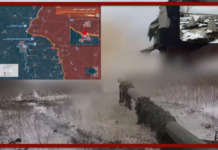
The month of May will be as delicate and decisive as February was in relations between the West and Russia, if we can still speak of relations.
The DefenderEurope2022 exercises are underway until the end of the month in nine European countries, including Poland: 18,000 soldiers from more than 20 countries are involved. On Polish territory, some 7,000 military personnel and 3,000 pieces of equipment will be involved in the exercises. The main objective is to practise the transfer of military contingents over long distances and the deployment of a group for a combat operation. The first phase of the exercise involves the capture of the city of Lviv in Ukraine by Polish NATO troops.
Added to this is the acceleration of the construction of the Trans-Baltic Rail Baltica: new tracks and modernisation of the railway lines at stations in the village of Elk in Poland (70 kilometres from the border with the Kaliningrad region). Rail Baltica is a greenfield rail transport infrastructure project with the aim of integrating the Baltic States into the European rail network. The project directly involves five European Union countries: the Republic of Poland, the Republic of Lithuania, the Republic of Latvia, the Republic of Estonia and indirectly the Republic of Finland.
The Rail Baltica project is also conceived as a military project to increase the mobility of NATO troops on the territory of Poland and the Baltic States.
Also in the last few days, the Ukrainian authorities have dismantled another monument to the Soviet soldier in the city of Stryi, in the Lviv region, in their work of ‘derussification’. In addition, on 1 May in Lviv, radical Polish nationalist groups tried to disrupt a service in an Orthodox church, shouting insults and threatening believers in the Ukrainian Orthodox Church with physical violence.
All this is not seen as a harbinger of dialogue with Moscow. On 3 May, Russian armed forces attacked the railway junction in the city of Lviv in western Ukraine, two substations were reportedly damaged. The city authorities report that due to the destruction of the railway substations, trains stopped at the entrance of Lviv and the city networks were also partially affected by delays.
Online, the Russians showed videos of the Russian armed forces’ missile flight over the Vinnitsa region, before hitting the Lviv railway junction. The news was confirmed on 5 May in a briefing by the Russian Defence Ministry: ‘With the help of high-precision weapons, six electrical traction substations were destroyed in the areas of the railway stations of Podbortsy, Lviv, Volonets, Timkovo and Pyatikhatka’. The Russian Ministry’s justification was that: “Through them there was delivery of arms and ammunition from the USA and European countries”.
During the month of May, therefore, full of exercises, it is to be expected that tensions will rise between NATO and Russia. And on the Russian side there will be special attention to all NATO movements on the border with Ukraine, and it will undermine in every way the possibility of getting weapons to the Ukrainian military from the Polish and Romanian borders.
On 5 May, the Russian Defence Minister, Sergei Shoigu, finally cleared the air of the inferences circulating in the social sphere and in the Western and Eastern media: striking a Western convoy carrying arms and ammunition for Ukrainian forces is a legitimate target.
From this statement, we can only expect a rise in strategic tension in the confrontation, for now at a distance, between West and East Europe.
Graziella Giangiulo

















